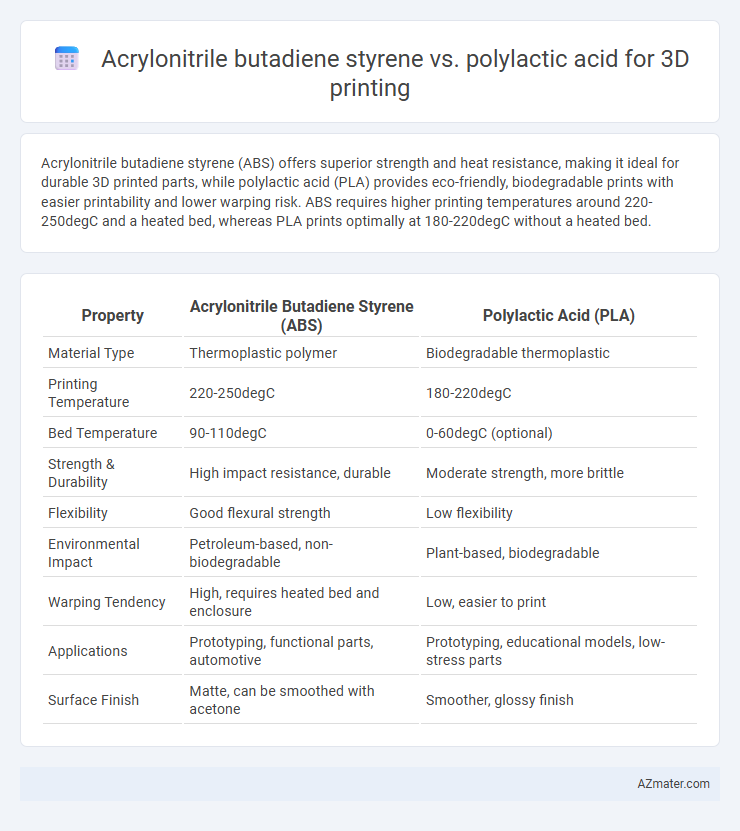Acrylonitrile butadiene styrene (ABS) offers superior strength and heat resistance, making it ideal for durable 3D printed parts, while polylactic acid (PLA) provides eco-friendly, biodegradable prints with easier printability and lower warping risk. ABS requires higher printing temperatures around 220-250degC and a heated bed, whereas PLA prints optimally at 180-220degC without a heated bed.
Table of Comparison
| Property | Acrylonitrile Butadiene Styrene (ABS) | Polylactic Acid (PLA) |
|---|---|---|
| Material Type | Thermoplastic polymer | Biodegradable thermoplastic |
| Printing Temperature | 220-250degC | 180-220degC |
| Bed Temperature | 90-110degC | 0-60degC (optional) |
| Strength & Durability | High impact resistance, durable | Moderate strength, more brittle |
| Flexibility | Good flexural strength | Low flexibility |
| Environmental Impact | Petroleum-based, non-biodegradable | Plant-based, biodegradable |
| Warping Tendency | High, requires heated bed and enclosure | Low, easier to print |
| Applications | Prototyping, functional parts, automotive | Prototyping, educational models, low-stress parts |
| Surface Finish | Matte, can be smoothed with acetone | Smoother, glossy finish |
Introduction to ABS and PLA Filaments
ABS (Acrylonitrile butadiene styrene) is a petroleum-based thermoplastic known for its strength, durability, and heat resistance, making it ideal for functional prototypes and mechanical parts in 3D printing. PLA (Polylactic acid), derived from renewable resources like corn starch, offers biodegradability and ease of printing with minimal warping, popular for detailed models and environmentally conscious applications. Both filaments serve distinct purposes, with ABS favored for toughness and impact resistance, while PLA excels in ease of use and eco-friendliness.
Material Properties Comparison: ABS vs PLA
Acrylonitrile butadiene styrene (ABS) offers higher impact resistance, greater toughness, and better thermal stability compared to Polylactic acid (PLA), which is more brittle but provides superior print detail and lower warping. PLA is biodegradable and derived from renewable resources, making it environmentally friendly, whereas ABS is petroleum-based and emits stronger fumes during printing. For applications requiring durability and heat resistance, ABS is preferred, while PLA suits prototypes, decorative objects, and eco-conscious projects due to its ease of use and biodegradability.
Printability: Ease of Use and Beginner Friendliness
Acrylonitrile butadiene styrene (ABS) offers strong heat resistance and durability but requires a heated bed and controlled environment to prevent warping, making it less beginner-friendly. Polylactic acid (PLA) prints at lower temperatures without a heated bed, producing minimal warping and odor, which enhances ease of use for beginners. PLA's compatibility with most consumer-grade 3D printers and lower printing difficulties make it the preferred choice for novice users.
Mechanical Strength and Durability
Acrylonitrile butadiene styrene (ABS) offers superior mechanical strength and impact resistance compared to polylactic acid (PLA), making it ideal for functional parts requiring durability under stress. PLA, while easier to print and biodegradable, exhibits lower tensile strength and is more brittle, limiting its use in high-impact or load-bearing applications. ABS also withstands higher temperatures and environmental wear, extending the lifespan of 3D-printed components in demanding conditions.
Environmental Impact and Biodegradability
Acrylonitrile butadiene styrene (ABS) is a petroleum-based plastic known for its strength and durability but poses significant environmental concerns due to its non-biodegradability and release of harmful fumes during printing. Polylactic acid (PLA), derived from renewable resources like corn starch, offers superior environmental benefits with its biodegradability and lower carbon footprint, making it a more sustainable choice for 3D printing. Despite PLA's lower heat resistance and mechanical strength compared to ABS, its compostable nature significantly reduces plastic waste and environmental pollution.
Thermal Resistance and Heat Tolerance
Acrylonitrile butadiene styrene (ABS) offers superior thermal resistance with a heat deflection temperature around 100degC, making it suitable for applications requiring durability under elevated temperatures. Polylactic acid (PLA), with a lower heat tolerance near 60degC, tends to deform or soften when exposed to higher temperatures, limiting its use in heat-intensive environments. The higher thermal stability of ABS supports functional prototypes and end-use parts subjected to heat stress, whereas PLA is favored for low-temperature, biodegradable projects.
Surface Finish and Post-Processing Options
Acrylonitrile butadiene styrene (ABS) offers a smoother surface finish compared to polylactic acid (PLA) due to its ability to be easily sanded and acetone-smoothed, resulting in a glossy and refined appearance. PLA typically produces a matte finish with visible layer lines but is easier to paint and glue during post-processing. Post-processing ABS involves chemical smoothing and high-temperature treatments, while PLA favors simpler methods like sanding, priming, and painting for enhanced aesthetics.
Cost and Availability Analysis
Acrylonitrile butadiene styrene (ABS) generally offers a lower material cost compared to polylactic acid (PLA), making it a budget-friendly option for large-scale or functional 3D printing projects. ABS is widely available in various grades and colors, ensuring consistent supply for industrial and hobbyist use, while PLA, derived from renewable resources, may have higher costs due to its eco-friendly production processes but benefits from broad availability as a popular biodegradable filament. Cost efficiency in ABS combined with its widespread availability supports applications requiring durability, whereas PLA's availability is driven by environmental demand despite slightly higher prices.
Ideal Applications for ABS and PLA in 3D Printing
Acrylonitrile butadiene styrene (ABS) is ideal for durable prototypes, automotive parts, and functional tools due to its high impact resistance, thermal stability, and toughness. Polylactic acid (PLA) excels in applications requiring biodegradability, ease of printing, and aesthetic quality, making it suitable for educational models, decorative items, and low-stress functional parts. ABS is favored for mechanical and heat-resistant components, while PLA suits rapid prototyping and eco-friendly projects in 3D printing.
Choosing the Right Filament for Your Project
Acrylonitrile butadiene styrene (ABS) offers superior impact resistance and thermal stability, making it ideal for functional prototypes requiring durability and heat resistance. Polylactic acid (PLA) excels in ease of use, biodegradability, and low warping, preferred for detailed aesthetic models and environmentally conscious projects. Selecting the right filament depends on balancing mechanical properties, environmental impact, and the specific demands of the 3D printing application.

Infographic: Acrylonitrile butadiene styrene vs Polylactic acid for 3D printing
 azmater.com
azmater.com